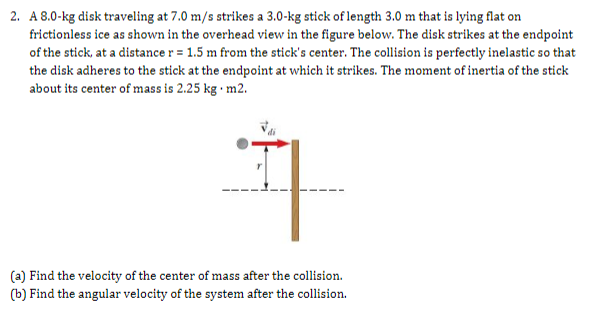2. A 8.0-kg disk traveling at 7.0 m/s strikes a 3.0-kg stick of length 3.0 m that is lying flat on frictionless ice as shown in the overhead view in the figure below. The disk strikes at the endpoint of the stick, at a distance r = 1.5 m from the stick's center. The collision is perfectly inelastic so that the disk adheres to the stick at the endpoint at which it strikes. The moment of inertia of the stick about its center of mass is 2.25 kg · m2. (a) Find the velocity of the center of mass after the collision. (b) Find the angular velocity of the system after the collision.
2. A 8.0-kg disk traveling at 7.0 m/s strikes a 3.0-kg stick of length 3.0 m that is lying flat on frictionless ice as shown in the overhead view in the figure below. The disk strikes at the endpoint of the stick, at a distance r = 1.5 m from the stick's center. The collision is perfectly inelastic so that the disk adheres to the stick at the endpoint at which it strikes. The moment of inertia of the stick about its center of mass is 2.25 kg · m2. (a) Find the velocity of the center of mass after the collision. (b) Find the angular velocity of the system after the collision.
Related questions
Question
thanks!

Transcribed Image Text:2. A 8.0-kg disk traveling at 7.0 m/s strikes a 3.0-kg stick of length 3.0 m that is lying flat on
frictionless ice as shown in the overhead view in the figure below. The disk strikes at the endpoint
of the stick, at a distance r = 1.5 m from the stick's center. The collision is perfectly inelastic so that
the disk adheres to the stick at the endpoint at which it strikes. The moment of inertia of the stick
about its center of mass is 2.25 kg · m2.
(a) Find the velocity of the center of mass after the collision.
(b) Find the angular velocity of the system after the collision.
Expert Solution
This question has been solved!
Explore an expertly crafted, step-by-step solution for a thorough understanding of key concepts.
This is a popular solution!
Trending now
This is a popular solution!
Step by step
Solved in 4 steps with 4 images
